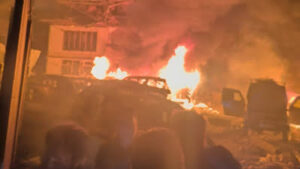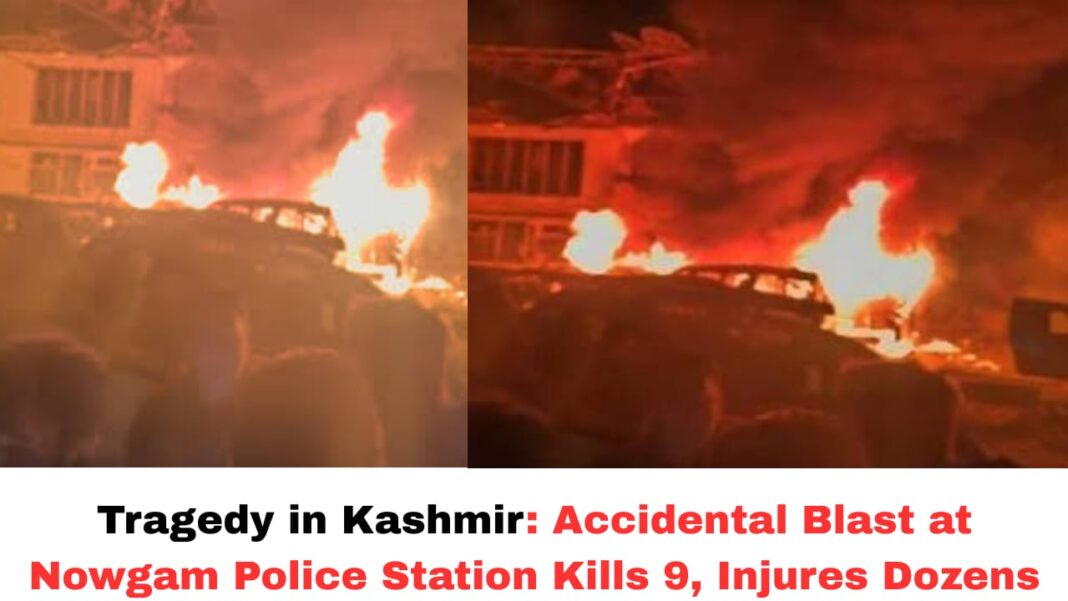Digital News Guru Kashmir Desk:
On the night of 14 November 2025, a devastating explosion ripped through the Nowgam Police Station on the outskirts of Srinagar, claiming the lives of nine people and leaving 27–32 others injured. Authorities have described the incident as an accidental detonation of a large cache of seized explosives, ruling out any militant involvement—but the scale and implications of the blast raise serious questions about safety, intelligence, and counterterror protocols.
360kg of Seized Explosives Detonate in Nowgam, Kashmir
The explosion occurred at approximately 11:20 pm, during a forensic examination of materials that had been seized from a so-called “white-collar terror module.” According to Jammu & Kashmir Police Director-General Nalin Prabhat, the cache—transported from Faridabad in Haryana—was being handled by forensic experts, police, and revenue officials when the materials detonated.

The site reportedly stored around 360 kg of explosive substances, including ammonium nitrate, potassium nitrate, sulfur, and other reagents. The magnitude of the blast was immense: debris and even human remains were found 100–200 meters away from the station, and secondary smaller explosions hampered immediate rescue efforts.
Casualties and Damage
The human cost was heavy. Among the deceased were:
- Three Forensic Science Laboratory (FSL) personnel
- Two revenue department officials, including a Naib Tehsildar
- Two crime-scene photographers
- One member of the State Investigation Agency (SIA)
- One tailor, who was reportedly assisting the investigation team at the station.
Meanwhile, dozens more were hospitalized: reports suggest 27 police officers, additional revenue staff, and a few civilians sustained injuries of varying severity. The building housing the police station suffered extensive damage, with windows shattered, structures weakened, and several vehicles inside the compound catching fire. Nearby residential homes also reported damage from the shockwave.
Investigation, Cause, and Official Response
From the outset, senior officials have insisted that there was no terror attack behind the blast. DGP Nalin Prabhat called it an “accidental explosion,” attributing it to the “unstable and sensitive nature” of the seized materials. The Ministry of Home Affairs (MHA) echoed this, with Joint Secretary Prashant Lokhande confirming that the recovered explosives were being forwarded for forensic and chemical examination when the detonation took place.
Officials emphasized that standard protocols were being followed: the explosive materials were stored in an open part of the station, and a Forensic Science Laboratory team had been working over two days to take chemical samples. Yet even with this caution, the inherent instability of the substances—especially in that volume—appears to have precipitated the disaster.
Adding weight to the accidental theory, surveillance footage from CCTV cameras captured the precise moment of the blast, showing the sudden, cataclysmic detonation. According to investigators, the main explosion triggered a chain of smaller blasts—likely from residual chemical residues scattered across the room—which delayed rescue teams from entering safely.

Background: The “White-Collar” Module
This horrifying incident is tied to a larger investigation that uncovered a Jaish-e-Mohammed–linked “white-collar” terror module. In recent weeks, authorities arrested several individuals, including doctors, and recovered nearly 2,900 kg of bomb-making materials across different locations.
The explosives stored at Nowgam were part of a haul recovered from Faridabad, linked to these detained suspects. Earlier intelligence had connected this network to threatening posters in the Nowgam area, and forensic teams were in the process of analyzing the material to build the case.
Reactions and Aftermath
In the wake of the blast, local and national authorities expressed shock and grief. The Jammu & Kashmir government announced ex-gratia compensation: 10 lakh (1 million) for the families of the deceased and 1 lakh for those seriously injured, to be disbursed from the Chief Minister’s Relief Fund.
Meanwhile, opposition and civil society voices have raised concerns. Some argue that the incident exposes serious gaps in how explosive materials are handled—even after seizure—and question why such a large amount was being stored at a police station rather than a more secure, dedicated facility. There is also public anxiety, given the proximity to a residential area and the potential risk such storage poses to civilians.
Security has been tightened in Srinagar and surrounding areas as investigators work to piece together exactly what went wrong. A high-level probe is underway, with experts assessing procedural lapses, chain-of-custody records, and whether any reforms in explosive storage and handling are urgently required.
Significance and Broader Implications
The Nowgam blast is not just a tragic accident; it underscores the dangerous complexity of counterterror investigations, especially in a heavily militarized region like Kashmir. While the link to a terror module places this firmly in the security domain, the nature of the tragedy—an internal mishandling rather than an external attack—raises fundamental questions:
- Safety Protocols: Are the current standard operating procedures (SOPs) for storing, sampling, and examining large caches of explosives adequate? Should more stringent standards be enforced, or should specialized bomb depots be used instead of police station premises?
- Risk Assessment: Given the volatile nature of recovered materials, how are law enforcement agencies assessing risk when planning forensic operations? Was risk under-estimated in this case?

- Transparency & Accountability: Families of victims, as well as the public, will demand transparency in the investigation. The authorities must build trust by sharing findings, clarifying where (if at all) negligence played a role, and outlining corrective steps.
- Terror Networks: The blast brings renewed focus to the “white-collar” terror module, possibly linked to major plots like the Delhi Red Fort car blast. Investigators will need to connect the dots carefully—both in terms of who orchestrated the wider terror plot and how such a dangerous arsenal ended up stored in a residential area.
Conclusion
The Nowgam police station blast marks an unsettling chapter in Kashmir’s ongoing security challenges. While now officially deemed an accident, the scale of destruction and loss of life is sobering. Authorities face a critical task: to deepen the investigation, refine their protocols, and reassure a public that is both fearful and grieving. In the aftermath, there is an urgent need not just for answers, but for systemic change—to ensure that the handling of explosive materials is safer, more accountable, and ultimately more secure.
You May Also Read: SARAS Aajeevika Mela 2025: A Celebration of Rural Women’s Entrepreneurship at Delhi Trade Fair








